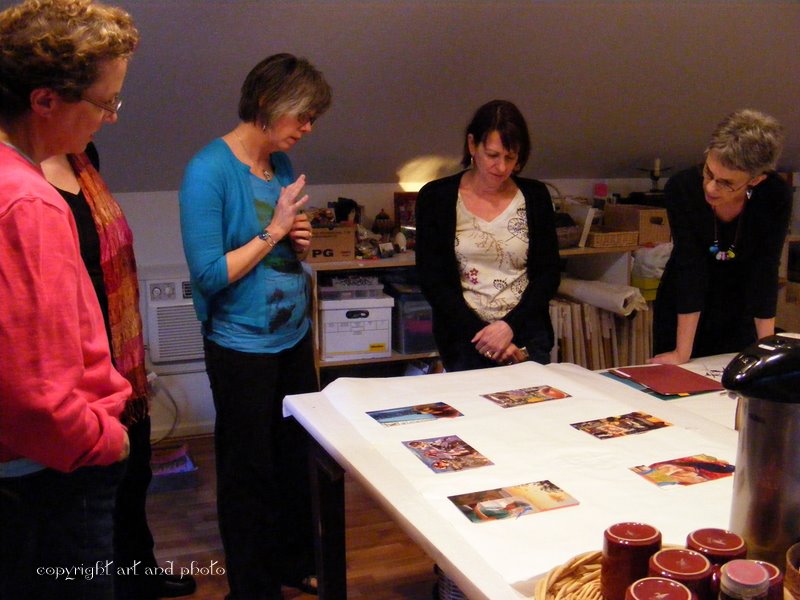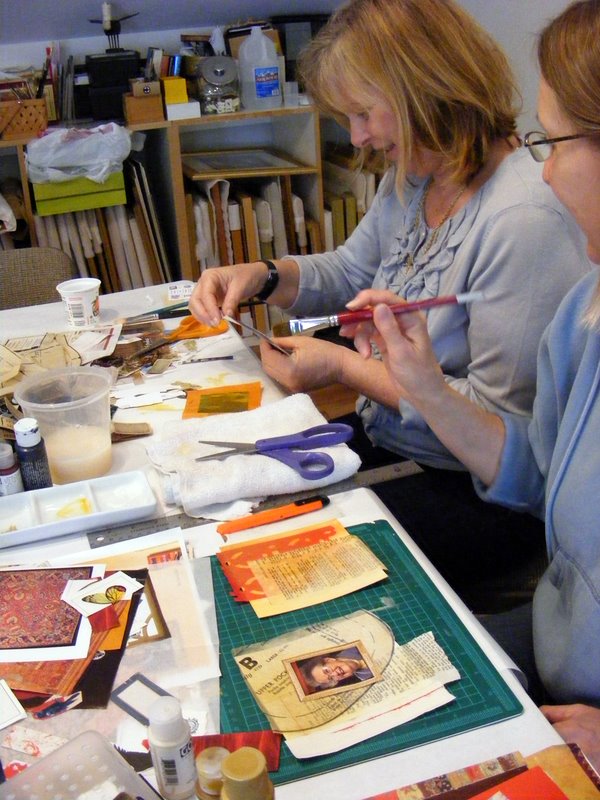Last week I found myself musing about gifts. As an artist and an art therapist, I spend a fair amount of time shifting between these crafts, wondering about the differences between art and art as therapy (hence this blog) and trying to balance the quality of effort that I devote to each. I often think that I could be very happy left to my own devices in the studio, but in fact, this is patently not true. I draw, no pun intended, much of my inspiration from the children with whom I work. When we make art together, I learn so much more about what it is to be a human being living and breathing and living on the earth at this time. My heart expands and thus does my vision. It's like the proverbial story of the blind men and the elephant. As the sightless men stand arrayed around the beast, a sage asks them to describe this animal. One man reaches up to the trunk and speaks of its roughness and length, another describes the sturdiness of a leg, another the back and yet another the tusks. Who has the true story? In other words one discipline feeds the other. This came to me clearly this morning after talking with my friend Beth Rommel about the subject. Soon, after that, I turned on the radio to hear Abraham Vergese, the physician and author. What I loved about listening to this man, was his absolute devotion and love of medicine. It didn't just serve to feed and clothe his family so that he could write, it was his wellspring of inspiration. The wonderful intertwining of these two disciplines was apparent in his description of his call to medicine which he relates came from reading Somerset Maugham's "Of Human Bondage." A physician called to writing through a fictional character who is also a doctor! It underscores my belief that art and writing, in particular, fiction writing, serve to tell us truths that we could not arrive at any other ways, truths for which there is no existing image or combination of words.
Photo credit: Lynn Cohen, copyright, 2010.
Teaching A SoulCollage® Workshop
Someone recently asked me to teach a workshop on SoulCollage®. It had been some time since I've taught a class on this method designed by Seena Frost, a therapist in Santa Cruz, CA. The process combines intuition and images and results in small 5" x 8" collage cards. Made over time, these cards accrue to become a deck of personal cards, which like playing cards, contain four different suits. Each card holds its own unique energy, particular to the person who made it. Because the process bypasses the conscious mind, the meaning of the card imparts itself over time, much like a dream.
 So it was this afternoon. Five women gathered together to explore the Community suit; those people in our lives with whom we are in relationship whether intimately or from a distance. Images where laid out along a window shelf, stacked in boxes and hidden within piles and piles of magazines. Xacto knives and glues were at the ready and scissors waited patiently. "What would emerge" I wondered? I asked myself if I'd been able to convey the idea of letting the images "pick you," but SoulCollage® didn't disappoint. At the end of the afternoon, each women's card held the essence of an important and beloved person in their life.
So it was this afternoon. Five women gathered together to explore the Community suit; those people in our lives with whom we are in relationship whether intimately or from a distance. Images where laid out along a window shelf, stacked in boxes and hidden within piles and piles of magazines. Xacto knives and glues were at the ready and scissors waited patiently. "What would emerge" I wondered? I asked myself if I'd been able to convey the idea of letting the images "pick you," but SoulCollage® didn't disappoint. At the end of the afternoon, each women's card held the essence of an important and beloved person in their life.
My gratitude to Lynn Cohen who generously shared her pictures of the class with me.
Recipe for a Collage Salon
For some time now I've been thinking about having a time and space where some of my artist friends could get together and make art and talk and eat and all those fun things that happen once in a blue moon. So today, on the day of the full moon and the Jewish holiday of Purim (not sure how this figures in yet) I'm opened up my studio to a number of artist friends.
In order to get ready, I took a look around the studio. Oh my. Everything must go. Not really. I spent some time arranging mediums & materials so that all of the supplies in view were usable. I wanted it to be inviting, with a sense that you could explore the shelves as if you were in a Moroccan souk or market, peering into this basket or that, taking a shiny piece of paper here, a thick colored pencil there, or perhaps sampling a brightly patterned fabric.
I added one table for tea, coffee, and things to munch on including some chocolate covered cacao beans, roasted almonds and purple grapes. I also laid out several books with good art work by collage artists. Food for the eyes.

 What actually took place after the invitations were sent out and the studio readied was beyond my imagination. As people arrived, they carried in bags of brilliantly printed fabrics, hampers stuffed with choice images, baskets of pencils and tiny bags filled with delicacies such as small printed cards of botanicals and birds. Two of the women had made a trip to Chinatown in Sacramento and appeared with joss papers, incense holders (crinkly pieces of tan paper with slits for incense) and delicately cut tissue paper doilies. One woman brought a bag of fresh grapefruits from her tree. What we had was a feast for the eyes and the soul. Introductions were made over and over and people talked excitedly, catching up, discovering connections between each other, and peering at the collages that were forming under numerous pairs of hands. I found myself trying to listen to all the conversations taking place at once.
What actually took place after the invitations were sent out and the studio readied was beyond my imagination. As people arrived, they carried in bags of brilliantly printed fabrics, hampers stuffed with choice images, baskets of pencils and tiny bags filled with delicacies such as small printed cards of botanicals and birds. Two of the women had made a trip to Chinatown in Sacramento and appeared with joss papers, incense holders (crinkly pieces of tan paper with slits for incense) and delicately cut tissue paper doilies. One woman brought a bag of fresh grapefruits from her tree. What we had was a feast for the eyes and the soul. Introductions were made over and over and people talked excitedly, catching up, discovering connections between each other, and peering at the collages that were forming under numerous pairs of hands. I found myself trying to listen to all the conversations taking place at once.
At the end, each women left with a collage (or two, or three) and, it seemed, a full heart. And, at the end, my daughter came up the stairs and the topic of Purim came up. Lizzie, my daughter told us the story of Esther. Although the few of us that were left weren't in costume (as is the custom), I felt as if the coming together of all the women and their diverse materials was its own kind of celebration.
What's the Real Story?
When I started out this series of posts, I was thinking about the different parts of an artist's statement. What, I asked myself, needs to come together in order to give the reader and viewer an insight into the work that I've constructed?
After I wrote the last two posts, I got to thinking. One of the things I've learned over the years is that for my art work to find it's way to a conclusion, I have to abandon a cognitive understanding of what I'm doing, the subject matter I'm working with and any story lines I might want to tell. I have to continually surrender to the presence and the process of the artwork, because otherwise the art has a way of becoming didactic, of becoming a one-to-one correspondence between my idea and the finished piece where there is no mystery and no middle ground where new ideas have present themselves.
That mode of working has it's downside. I realized that after many years of working this way, I don't stop to figure out what the story is that I've told. "Oh my goodness," I thought to myself, "there lies undiscovered riches." I mentioned compost in the last entry. I think that unless I stop to reflect on the finished piece of art work, I'm missing the valuable "compost" for the next.
Day's End
At the end of the day, ideas gather. The hours of February 13th lay unfurled behind me and all of the things I wanted to do or dreamed of doing collect into this wonderfully rich compost. The ideas I've been holding inside of me combine with my regret that I didn't try them out--and I'm off. This is where inspiration begins.





